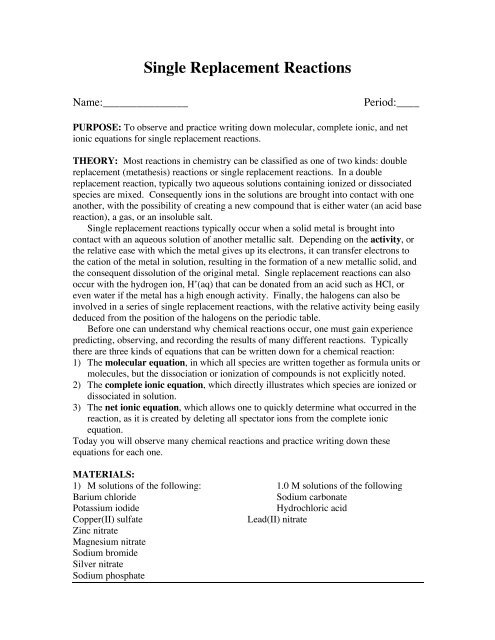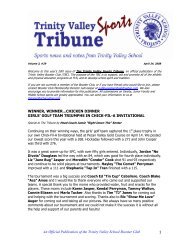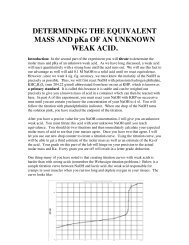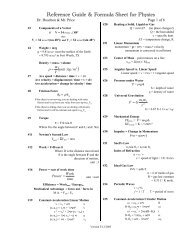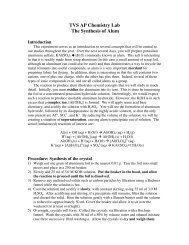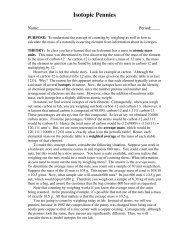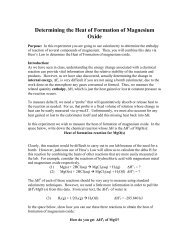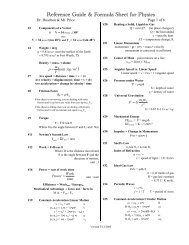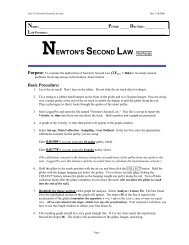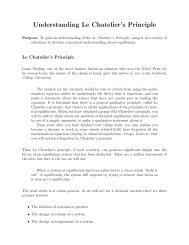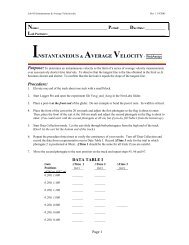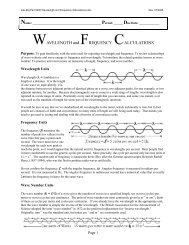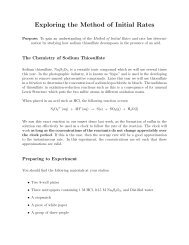Lab XII - Single Replacement Reactions
Lab XII - Single Replacement Reactions
Lab XII - Single Replacement Reactions
- No tags were found...
Create successful ePaper yourself
Turn your PDF publications into a flip-book with our unique Google optimized e-Paper software.
<strong>Single</strong> <strong>Replacement</strong> <strong>Reactions</strong>Name:_______________Period:____PURPOSE: To observe and practice writing down molecular, complete ionic, and netionic equations for single replacement reactions.THEORY: Most reactions in chemistry can be classified as one of two kinds: doublereplacement (metathesis) reactions or single replacement reactions. In a doublereplacement reaction, typically two aqueous solutions containing ionized or dissociatedspecies are mixed. Consequently ions in the solutions are brought into contact with oneanother, with the possibility of creating a new compound that is either water (an acid basereaction), a gas, or an insoluble salt.<strong>Single</strong> replacement reactions typically occur when a solid metal is brought intocontact with an aqueous solution of another metallic salt. Depending on the activity, orthe relative ease with which the metal gives up its electrons, it can transfer electrons tothe cation of the metal in solution, resulting in the formation of a new metallic solid, andthe consequent dissolution of the original metal. <strong>Single</strong> replacement reactions can alsooccur with the hydrogen ion, H + (aq) that can be donated from an acid such as HCl, oreven water if the metal has a high enough activity. Finally, the halogens can also beinvolved in a series of single replacement reactions, with the relative activity being easilydeduced from the position of the halogens on the periodic table.Before one can understand why chemical reactions occur, one must gain experiencepredicting, observing, and recording the results of many different reactions. Typicallythere are three kinds of equations that can be written down for a chemical reaction:1) The molecular equation, in which all species are written together as formula units ormolecules, but the dissociation or ionization of compounds is not explicitly noted.2) The complete ionic equation, which directly illustrates which species are ionized ordissociated in solution.3) The net ionic equation, which allows one to quickly determine what occurred in thereaction, as it is created by deleting all spectator ions from the complete ionicequation.Today you will observe many chemical reactions and practice writing down theseequations for each one.MATERIALS:1) M solutions of the following: 1.0 M solutions of the followingBarium chlorideSodium carbonatePotassium iodideHydrochloric acidCopper(II) sulfateLead(II) nitrateZinc nitrateMagnesium nitrateSodium bromideSilver nitrateSodium phosphate
Copper(II) nitratePotassium chlorideSolid samples of:CopperMagnesiumZincSilverSodium24 well plate (see figure below)Plastic Beral Pipets1% Phenolphthalein solutionSchematic Diagram of 24-well Plate (shown with where each metal is placed)1 2 3 4 5 6A Copper Copper Copper Copper copperB Mg Mg Mg Mg MgC Zn Zn Zn Zn ZnD Ag Ag Ag Ag AgPRELAB: All parts must be completed before you can begin the lab.Copy the following tables exactly into your lab book. Use a minimum of a full pagefor Table IData Table I – <strong>Single</strong> <strong>Replacement</strong> <strong>Reactions</strong>:Well Reactants ObservationsA2 Solid copper andMagnesium nitrateA3 Solid copper andSodium nitrateA4 Solid copper andZinc nitrateA5 Solid copper andSilver nitrateA6 Solid copper andHydrochloric acid
B1B3B4B5B6C1C2C3C5C6D1D2D3D4D6Solid magnesium andCopper(II) nitrateSolid magnesium andSodium nitrateSolid magnesium andZinc nitrateSolid magnesium andSilver nitrateSolid magnesium andHydrochloric acidSolid zinc andCopper(II) nitrateSolid zinc andMagnesium nitrateSolid zinc andSodium nitrateSolid zinc andsilver nitrateSolid zinc andhydrochloric acidNote: The D wells will beSolid silver andCopper(II) nitrateSolid silver andMagnesium nitrateSolid silver andSodium nitrateSolid silver andZinc nitrateSolid silver andhydrochloric acidDone by the instructor
Data Table II – The Reaction of sodium with waterExperiment Reactants ObservationOneSolid sodium added towaterTwoSolid sodium added towater withphenolphthaleinCALCULATIONS:<strong>Single</strong> <strong>Replacement</strong> <strong>Reactions</strong> and the reactions of sodium.For each reaction that occurred, write down the molecular, complete ionic and net ionicequations for the reaction. Clearly show in your calculation which reaction well you arediscussing. For example, for well B1 you should write:Reaction for well B1:ME : Mg(s) + Cu(NO 3 ) 2 (aq) Mg(NO 3 ) 2 (aq) + Cu(s)CIE: Mg(s) + Cu 2+ (aq) + 2NO 3 - (aq) Cu(s) + Mg 2+ (aq) + 2NO 3 - (aq)NIE: Mg(s) + Cu 2+ (aq) Mg 2+ (aq) + Cu(s)Show this process for each reaction. If the same reaction occurred in more than one well,you may write the reaction once, and then refer to it for subsequent wells. If no reactionoccurs, clearly state that. For example, if nothing happened in well C6, sayReaction for well C6: No Reaction, or NRNow look at your reactions. The solid metal that produced the greatest number ofreactions is the most active. From your data produce your own clearly labeled activityseries from the metals (Cu, Na, Mg, Zn, Ag) and the hydrogen ion. Compare yourordering to that of the activity series in the text, explaining any differences.<strong>Reactions</strong> of sodium:Write down the ME, CIE, and NIE for this reaction.DISCUSSION: Answer the following questions neatly and in complete sentences in yourlab book.a) Explain the fundamental difference between single and double replacement reactions.b) Recall we discussed the white coating that is formed on the sodium metal as it standsin air. Write a balanced chemical equation for this reaction, and state what kind ofreaction this is.c) Explain why the solution turned pink when phenolpthalein was added to the reactionof sodium with water. What could be added to make the solution return to a clearcolor?
d) Explain why one would never want to use water to put out a fire that involved analkali metal.e) Why is sodium hydroxide the product of the reaction of sodium with water instead ofsodium oxide?f) If one placed 25 g of sodium metal in water, how many grams of hydrogen gas wouldbe made?Be sure to complete your lab with a meaningful conclusion!Procedure: <strong>Single</strong> <strong>Replacement</strong> <strong>Reactions</strong>A– Activity series of metals1) Once again obtain a clean and dry well plate.2) Place 20 drops of copper(II) nitrate into wells B1 and C1.3) Place 20 drops of magnesium nitrate into wells A2, and C24) Place 20 drops of sodium nitrate into wells A3, B3, and C3.5) Place 20 drops of zinc nitrate into wells A4 and B46) Place 20 drops of silver nitrate into wells A5, B5, C5,7) Place 20 drops of hydrochloric acid into wells A6, B6, C6,8) Insert one piece of copper metal into each filled well of the A row.9) Insert one piece of magnesium metal into each filled well of the B row.10) Insert one piece of zinc metal into each filled well of the C row.11) The instructor will have a well set up showing the reaction of silver metal with eachsolution. Make sure you look at this plate and record appropriate observations.12) If needed, gently shake the well plate to submerge all of the metal. It is ok if a smallamount of the metal rests above the solution.13) Record observations once all metal pieces have been inserted, and then again after 5minutes. At this time the instructor will do the sodium demo. After this is completed,make a final set of observations to see if anything has changed.14) Dump the contents of all wells into the waste beaker provided. Use Q-tips to removeany pieces of metal stuck in the wells. Clean the plate with soap solution, tap water,and distilled water. Return to you desk for class discussion.F – The reaction of sodium metal with water.The instructor will demonstrate the reaction of sodium with water. Record observationsfor both demonstrations.


